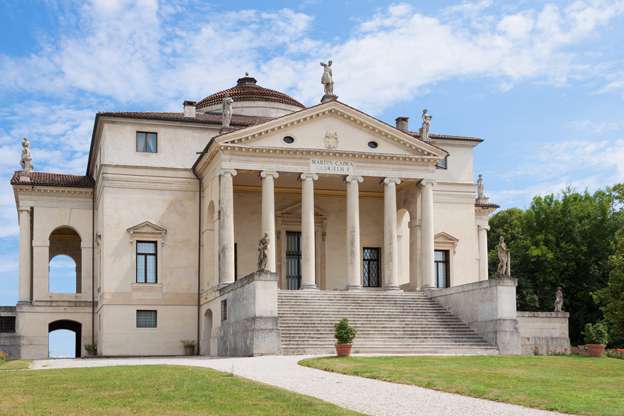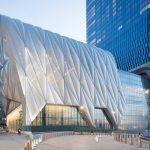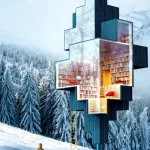The term Palladian architecture brings to mind formal buildings and sprawling mansions in the classical style. Palladio started out inspired by the Romans and rather outdid them with the originality of his own vision. His buildings are a must see for everyone interested in architecture.
Andrea Palladio was one of the leading architects of Northern Italy in the sixteenth century. He was – and still is – renowned for the splendid, symmetrical villas, civic buildings and churches that he built in Vicenza and Venice. The term ‘Palladian’, on account of the highly original structures he designed, has come to represent timeless elegance and grandeur.
Palladio’s real name was Andrea di Pietro della Gondola and he was born in Padua in 1508. He was apprenticed as a stonemason at the age of thirteen in Padua under Bartolomeo Cavazza da Sossano, but, after eighteen unhappy months of apprenticeship there, he left to find another position as an assistant at the Pedemuro studio in Vicenza. He probably would have continued as a talented stonemason, except, in his early thirties, his path crossed with that of the nobleman Giangiorgio Trissino, a leading writer and humanist thinker of the period.
A multi-faceted personality, Trissino had recently designed his own villa in Cricoli and he met Palladio in the course of commissioning the work on it. Impressed with the young stonemason’s intelligence and personality, Trissino took him under his wing and helped launch his career as one of the most sought after architects of the day. He conferred on him the name Palladio, derived from the Greek Goddess of Wisdom Pallas Athene, and introduced him to other important personalities in Vicenza.
Under first Trissino’s guiding influence and later under the patronage of the powerful brothers Daniele and Marcantonio Barbaro, Palladio immersed himself in obtaining a classical education, and made an extensive study of Roman architectural remains as well as the works of famous architects like Michele Sanmicheli, Jacopo Sansovino and Donato Bramante. Along with these studies, Palladio read the architectural theory writings of Vitruvius and Alberti and was inspired to create new forms from old designs; herein lies his genius. The former stonemason went on to become the Chief Architect of the Venetian Republic, and designed buildings that still astound and impress.
Palladio was also an accomplished writer and theorist. Amongst other works, he published ‘L’antichita di Roma’, a guide to Roman antiquities, in 1554, and published the scholarly and extensive architectural treatise ‘I Quattro Libri dell’Architettura’ in 1570. The latter publication contains detailed theoretical and practical information of architectural principles, and includes the details and plans of his own works. This book is still in publication and is referred to by architectural students.
Palladio died in 1580 in Vicenza
Palladio built churches and public buildings, but the villas he built are something extraordinary. Never before had anyone come up with private residences in quite this grand mold. While Alberti had written about villas in his works earlier, building villas was at that point a new fashion amongst the rich Northern Italian patrons who commissioned architectural works; until then they had been mostly concerned with building and living in well-fortified castles or strongholds. Now with farming becoming more lucrative, people wanted countryside homes and Palladio was just the architect to design them.
The villas that Palladio designed were usually constructed on city outskirts or at a good distance away in the countryside and were part of a farming estate. Palladio built more of the second than the first. The villas had the following characteristics –
○ A well-balanced, harmonious, symmetrical design. The perfection of the design caused Palladian villas to be much imitated in Georgian England, in America and around the world. The design ideas still find favor with modern-day architects.
○ A main block, with wings stretching out on either side. The wings were as much to give an impression of a structure embracing the surrounding countryside as well as to connect the main block to the outhouse structures. Such a connection enabled the house owner to check on the activities and animals in the outbuildings without needing to step out in foul weather. The distance of the outbuildings from the central block also ensured that there was little or no question of being plagued with farm animal smells in the main house.
○ A classical portico with columns and pediment at the front of the central main block. In the famous Villa Capra, also known as Villa Rotonda, Palladio placed four classical porticoes, one in each of the four cardinal directions.
Some Other Palladian Buildings
○ The Church of San Giorgio Maggiore, on the island across the Canale San Marco, opposite the Doges’ Palace in Venice. Begun in 1566 and facade completed by Vincenzo Scamozzi in 1610.
○ Villa Barbaro, Maser, near Castelfranco, 1550-60, a country villa with interior frescoes by Veronese.
○ Palazzo Chiericati, Vicenza, begun in 1551, but not completed until the seventeenth century.
○ Palazzo della Ragione, also known as Basilica, Vicenza, begun in 1549 and completed in 1614.
As happens in modern times, financial issues dominated architectural concerns in Palladio’s time too. Many of Palladio’s buildings started off rather different on paper; the designs were always usually amended to meet the requirements of the clients or any structural changes or refinements. Many of his designs were not executed in his lifetime or were completed later, based on his plans, by other architects.



Comments are closed